This article describes different types of Resistors and their Applications. The resistors are categorized into fixed, variable, linear, non-linear, and magneto types of resistors. A resistor is a passive circuit component used in electronic circuits to introduce electrical resistance or electrical friction to the movement of electrons.
What is an Electrical Resistor?
A Resistor is an electrical component that offers resistance in a circuit in which it is connected either in series or parallel combination. It has 2 terminals and can be used to reduce or regulate the flow of current and lower the voltage level in a circuit. As the value of the resistor increases, there will be less current.
Resistors are designed with a specific value of resistance measured in Ohm (Ω), which indicates the strength of opposition to the electric current.
Resistance – The opposition to the flow of electric current is called Resistance. Its unit is Ohm (Ω).
Types of Resistors
There are following types of resistors.
- Linear Resistor
- Fixed Resistor
- Carbon Composition Resistor
- Wire Wound Resistor
- Thin Film Resistor
- Carbon Film Resistor
- Metal Film Resistor
- Thick Film Resistor
- Fusible Resistor
- Metal Oxide Resistor
- Cermet Resistor
- Fixed Resistor
- Variable Resistors
- Potentiometer
- Rheostat
- Trimmer
- Non-linear Resistors
- Thermistor
- Light Dependent Resistor LDR
- Varistor
- Surface Mount Resistors
- Power Resistors
- Magneto-resistors
Now, we will discuss each type of resistor in detail.
Linear Resistors
The resistors whose value changes with the voltage applied across it and temperature is called Linear Resistors. There is a linear relationship between applied voltage and the current flowing through it. Linear resistors are classified into the following two types:
- Fixed resistor
- Variable resistor
Applications of Linear Resistors
Linear resistors can be used in the following domains:
- Voltage and current limiting
- Voltage divider
- Biasing and stabilization
- Current sensing
- Termination resistors
Fixed Resistors
The resistors whose resistance value cannot be changed or the resistance is constant are called Fixed Resistors. The following are some important types of fixed resistors:
- Carbon composition resistors
- Wire wound resistors
- Thin film resistors
(1). Carbon Composition Resistors:
A solid cylindrical resistive element with integrated wire leads or metal end caps to which the lead wires are joined makes up the carbon composition resistor. It is made of carbon powder and graphite.

In the above picture, there is a black portion which is a solid cylindrical rod, which is made of carbon powder and graphite. Along with it, there are metal end caps connected with the leads.
- It is ideal for high frequency.
- Very cheap to make
- Available within 1ohm to 25 mega ohms
Applications of Carbon Composition Resistors:
- General circuit protection
- High voltage applications
- Voltage surge protection
- Power control and Snubber circuits
- Amplifier and Audio applications
(2). Wire Wound Type Resistors:
A wire-wound resistor is a resistor made by winding a resistive wire around a core or substrate. It is intended to give exact and steady resistance values, as well as strong power handling and low inductance.

As we can see in the above picture, there is a porcelain or ceramic substrate or core. There is a resistive wire on it in helical form. This resistive wire can be Nickel, Chromium, or Manganin as they can present more resistance in less length. Both ends of the wire are connected with the metal strips as an external connection. In this way, a wire wound resistor is made.
We can change the resistance of the wire wound resistor by following methods:
- By changing the resistivity of metal wire
- Altering the length of the metal wire
- By changing the cross-sectional area of the metal wire
Applications of Wire Wound Resistors:
- Power Electronics
- Dynamic braking
- Heating and temperature control
- Precise measurement
- Current sensing
(3). Thin Film Type Resistors:
A resistor, which uses a thin film of resistive layer is called a thin film resistor.
Thin film resistors are used to limit and reduce the electric current in a circuit. These are generally used in various electronic devices due to their small size, precise resistance value, and good stability.
Thin film resistors are typically made by depositing a thin resistive film onto a ceramic. Thin film resistors are known for their high precision and accuracy in resistance values. They can achieve tight tolerance levels, typically ranging from 1% to 0.01%, meaning the actual resistance of the component will be within the specified range. Thin film resistors typically have a low-Temperature coefficient of resistance values, which means their resistance remains relatively stable over a wide temperature range.
There are two types of thin film resistors.
- Carbon Film Resistor
- Metal film Resistor
(3a). Carbon Film Resistor
Carbon Film resistors have a substrate that is made up of an insulating material rod of high-grade ceramic material. A thin layer of carbon is overlaid around the rod. These types of resistors have better performance than the solid carbon resistor.

They produce negligible noise. The carbon film has a slightly negative temperature coefficient of resistance. This property is very useful for some electronic circuits.
(3b). Metal Film Resistor
The construction of the metal film resistor is the same as the carbon film resistor. The metal film resistor consists of a metal film made up of metal oxides, Nickle Chromium, or a mixture of glass and metals.
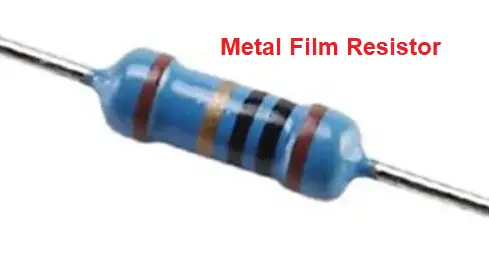
Metal film resistors have very low tolerance values, low noise, and good stability. The temperature coefficient of these resistors is very low (±2 ppm/°C).
The film resistor can be made up to a value of 10 GΩ. They are much smaller than wire wound resistors. Also, these resistors have non-inductive properties.
The resistance value of the carbon film and metal film resistors is shown by the color band on the resistor. Carbon film resistors and metal film resistors usually have 4 color bands and 5 color bands respectively.
Applications of Thin Film Resistors:
- Telecommunication equipment
- Consumer electronics
- Medical devices
- Precise measurement equipment
- Industrial Automation
(4). Thick Film Type Resistors
The construction of a thick film resistor is similar to a thin film resistor. As its name implies- a thick film resistor has thick resistive film instead of thin film. The followings are the types of thick film resistors.
- Fusible Resistors
- Metal Oxide Resistors
- Cermet Film Resistor
(4a). Fusible Type Resistor
The fusible resistor’s construction is similar to a wire wound resistor.
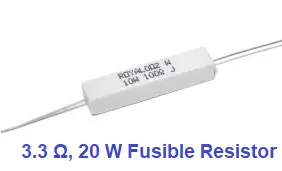
It performs two functions, it limits the current, and breaks or opens the circuit if the circuit current exceeds the specified value. The resistance value of these resistors is less than 10 Ohms.
Applications of Fusible Type Resistor
- TV sets
- Amplifiers
- Electronic Circuits
(4b.) Metal Oxide Type Resistors
Metal oxide resistors are made by oxidizing a thick film of Tin Chloride on a heated glass rod (substrate).
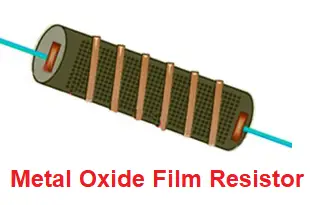
These resistors have high-temperature stability and very low noise. They can be used at high voltages. The maximum operating temperature of a metal oxide resistor is 450 °C.
(4c.) Cermet Film Type Resistor
The internal area of the resistor has ceramic insulation material. On the ceramic insulating material, a layer of carbon or metal film is wrapped and then it is fixed on the ceramic material. The ceramic material is known as cermet.
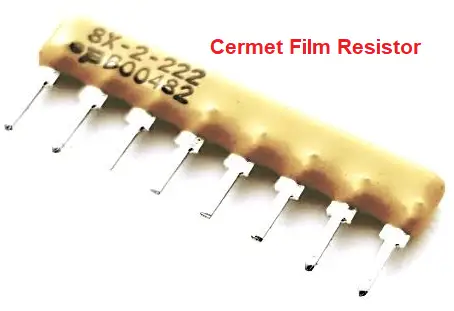
They are available in square and rectangular shape. The pins are under the resistor body and can be easily inserted into the printed circuit board. These resistors have good temperature stability.
(5). Variable Resistors
The resistors whose value can be changed using a knob or screw over it, are called Variable resistors. In this type of resistor, there is a limit to the minimum and maximum value of resistance offered by it. For example. There is a variable resistor of value 1kΩ-10kΩ. So, here, we can choose any value between this limit by adjusting the knob or screwing over it.
It can be used to reduce the current or lower the voltage level to the desired point by adjusting the resistance.
The following are common types of variable resistors:
- Potentiometer
- Rheostat
- Trimmer
(5a). Potentiometer:
A Potentiometer is a manually adjustable variable-type resistor. We can easily change the value of resistance by moving the knob on top of the potentiometer. A Potentiometer has 3 terminal or connection points, among 2 are fixed and one is variable. Both ends of the resistive element are linked to the two fixed outer terminals. The variable middle terminal is connected to the sliding contact for variable resistance.

The sliding contact and one fixed terminal can give multiple combinations of resistance. If the distance of sliding contact from the fixed terminal increases, then resistance will increase. If the distance of sliding contact from the fixed terminal decreases, then resistance will decrease.
Applications of the Potentiometer:
- Volume control
- Brightness and Contrast control
- Dimmer switches
- Wheatstone bridge
- Test and measurement
(5b). Rheostat:
A device that can be used to control the electric current is called Rheostat. This is done by varying the resistance in a circuit without any disturbance. Its construction is similar to the potentiometers. Rheostat can be used for both AC and DC. Rheostat-type resistors can be either rotary control or sliding control.

For Example, Rheostat is used in fan dimmers that can change the speed according to requirement. This regulator or dimmer is changing the resistance or controls the current.
There are 3 terminals of Rheostat. Two terminals are directly connected with the end coils. And the third terminal is connected to the metallic path at which the sliding contact will move. The coil is wrapped in insulating material.
Applications of Rheostat:
- Fan dimmer
- Light dimmer
- Motor speed
- Volume control
- Heater temperature control
(5c). Trimmer:
A variable resistor that can be used for the adjustment of tunes as well as calibration of circuits. It can be adjusted to the exact resistance.

It is mounted directly on the circuits. Trimmer-type resistors can be single or multi-turn. The multi-turn trimmer resistors can provide high resolution.
Applications of Trimmer:
- Calibration
- Circuit Adjustment
- Sensitivity control
- Offset compensation
- Potentiometer replacement
(6). Non-Linear Type Resistors
The resistors whose resistance change with the change in applied voltage or temperature but not according to Ohm’s law, are called Non-Linear resistors. Unlike linear-type resistors whose resistance is fixed, non-linear resistors exhibit non-linear characteristics. They are used in applications where non-linear response is desired such as voltage regulation. Some common examples of non-linear resistors are as follows:
- Thermistor
- Light-dependent resistor
- Varistor
(6a). Thermistor:

Thermistors are temperature-sensitive resistors whose resistance varies with temperature. There are two types, Negative Temperature Coefficient (NTC) thermistors, which decrease resistance with increasing temperature, and Positive Temperature Coefficient (PTC) thermistors, which increase resistance with increasing temperature. They are commonly used for temperature sensing, compensation, and control.
Applications of Thermistor:
- Temperature sensing
- Temperature compensation
- Thermostat
- Weather stations
- Fire alarm
(6b). Light-Dependent Resistor (LDR):

It is a resistor, that changes its resistance based upon the intensity of light falling on it. It works on the photoconductivity principle. It will offer high resistance in low light while low resistance in high light conditions.
Applications of Light-Dependent Resistor:
- Solar street lamps
- Laser-based security system
- Automatic light control
- Garden Irrigation control
- Display brightness control
(6c). Varistor:

Varistor is a device, that exhibits non-linear characteristics and is used to protect the electronics circuits from transient over-voltages. It has the same characteristics for both directions of the traversing current. They are available with AC operating voltages from 2.5V to 6000V.
Applications of Varistor:
- Surge protection devices
- Power distribution system
- Industrial control system
- Telecommunication
- Power supplies
(7). Surface Mount Resistors
Surface Mount Resistors are rectangular in shape. These resistors are also called SMD (surface mount device) resistors.
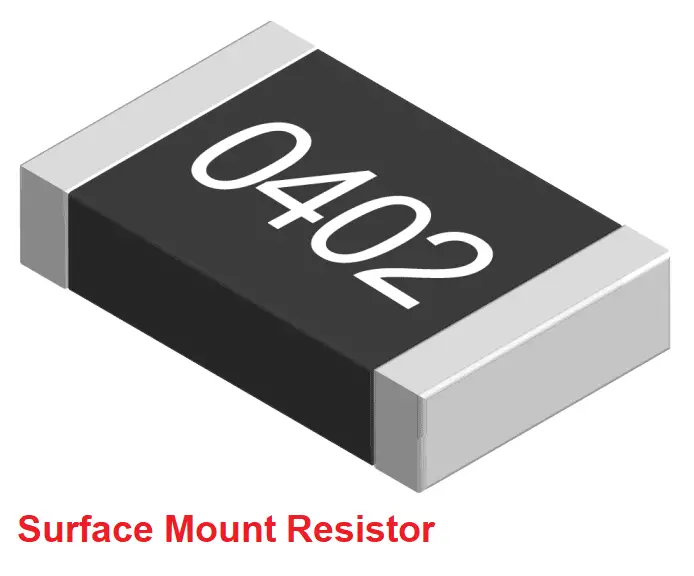
SMD resistors can be easily mounted on surface-mounted PCB technology. These resistors are Compact in size.
(8). Power Resistors
The power resistors can withstand and dissipate a large amount of heat. They are made up of high thermal conductivity material that allows efficient cooling.
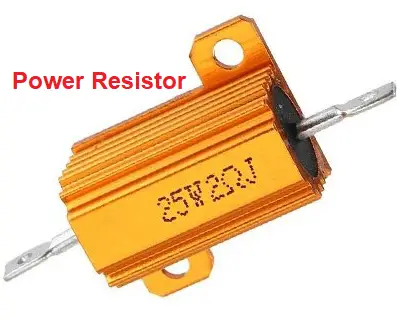
They are provided with a heat sink to dissipate the temperature in the environment. For large power rating resistors, forced air cooling or liquid cooling arrangement is made.
(9). Magneto-resistors
A magneto-resistor changes its resistance with the magnetic field strength and direction. The magneto-resistor functions on the principle of the magnetoresistance effect.
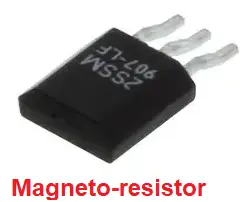
It is used for detecting and measuring the magnetic field.
Conclusion
In this article, we learn that A Resistor is an electrical component that offers resistance in a circuit in which it is connected either in series or parallel combination. It has 2 terminals and can be used to reduce or regulate the flow of current and lower the voltage level in a circuit.
As the value of the resistor increases, there will be less current. The resistors whose value changes with the voltage applied across it and temperature is called Linear Resistors. There is a linear relationship between applied voltage and the current flowing through it.
The resistors whose resistance change with the change in applied voltage or temperature but not according to Ohm’s law, are called Non-Linear resistors. Unlike linear resistors whose resistance is fixed, non-linear resistors exhibit non-linear characteristics. Further, we have studied the types of linear and non-linear resistors in detail and all of their applications.